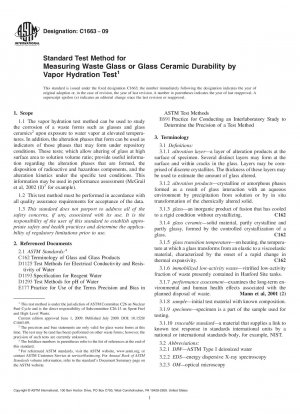ASTM C1663-09
Standard Test Method for Measuring Waste Glass or Glass Ceramic Durability by Vapor Hydration Test
- Standard No.
- ASTM C1663-09
- Release Date
- 2009
- Published By
- American Society for Testing and Materials (ASTM)
- Status
- Replace By
- ASTM C1663-17
- Latest
- ASTM C1663-18
- Scope
The vapor hydration test can be used to study the corrosion of glass and glass ceramic waste forms under conditions of high temperature and contact by water vapor or thin films of water. This method may serve as an accelerated test for some materials, since the high temperatures will accelerate thermally activated processes. A wide range of test temperatures have been reported in the literature –40°C (Ebert et al, 2005 (3), for example) to 300°C (Vienna et al, 2001 (4), for example). It should be noted that with increased test temperature comes the possibility of changing the corrosion rate determining mechanism and the types of phases formed upon alteration from those that occur in the disposal environment (Vienna et al, 2001 (4)).
The vapor hydration test can be used as a screening test to determine the propensity of waste forms to alter and for relative comparisons in alteration rates between waste forms.
1.1 The vapor hydration test method can be used to study the corrosion of a waste forms such as glasses and glass ceramics upon exposure to water vapor at elevated temperatures. In addition, the alteration phases that form can be used as indicators of those phases that may form under repository conditions. These tests; which allow altering of glass at high surface area to solution volume ratio; provide useful information regarding the alteration phases that are formed, the disposition of radioactive and hazardous components, and the alteration kinetics under the specific test conditions. This information may be used in performance assessment (McGrail et al, 2002 (1) for example).
1.2 This test method must be performed in accordance with all quality assurance requirements for acceptance of the data.
1.3 This standard does not purport to address all of the safety concerns, if any, associated with its use. It is the responsibility of the user of this standard to establish appropriate safety and health practices and determine the applicability of regulatory limitations prior to use.
ASTM C1663-09 Referenced Document
- ASTM C162 Standard Terminology of Glass and Glass Products
- ASTM D1125 Standard Test Methods for Electrical Conductivity and Resistivity of Water
- ASTM D1193 Standard Specification for Reagent Water
- ASTM D1293 Standard Test Methods for pH of Water
- ASTM E177 Standard Practice for Use of the Terms Precision and Bias in ASTM Test Methods
- ASTM E691 Standard Practice for Conducting an Interlaboratory Study to Determine the Precision of a Test Method
ASTM C1663-09 history
- 2018 ASTM C1663-18 Standard Test Method for Measuring Waste Glass or Glass Ceramic Durability by Vapor Hydration Test
- 2017 ASTM C1663-17 Standard Test Method for Measuring Waste Glass or Glass Ceramic Durability by Vapor Hydration Test
- 2009 ASTM C1663-09 Standard Test Method for Measuring Waste Glass or Glass Ceramic Durability by Vapor Hydration Test
